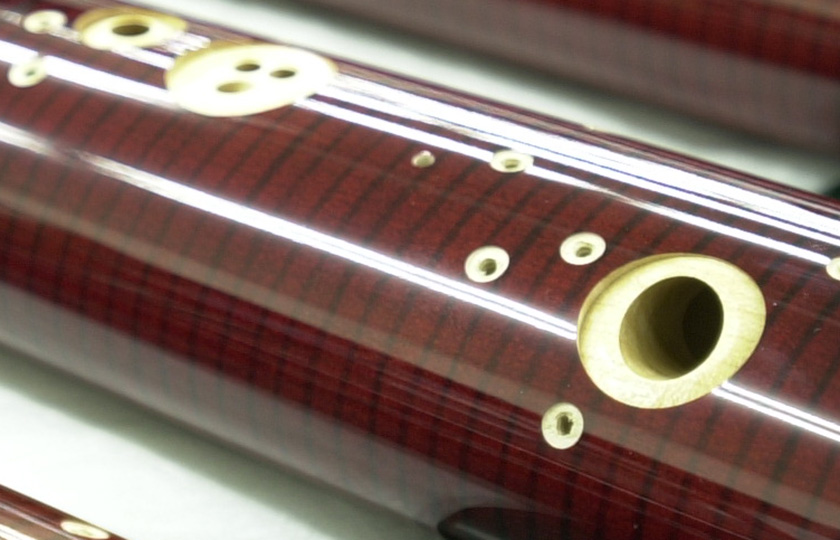The Structure of the Bassoon
Unique Features of the bassoon, and How to Play
Is it difficult for the bassoonist to hear the sound of their instrument?
It is often thought that the sound of the bassoon is difficult for the bassoonist themselves to hear, as the bell is high up at the top of the instrument, but that is actually not the case. For brass instruments that have no tiny openings through the rest of their structure, the bell is the only place where sound can emerge, but as a woodwind instrument the bassoon has tone holes here and there, so like other woodwind instruments, sound can escape through the tone holes that are not being pressed at any given time. That said, just when playing the very lowest note, it may be somewhat difficult to hear. When this note is played all the tone holes are covered, so at this time the sound does not emerge from the instrument anywhere other than the bell at its top.
Hearing the sound move?
Since the bassoon is a tall, slender instrument, the positions of the tone holes can be comfortably spaced some distance apart over its full length. For this reason, with the very lowest tone coming from the bell and then the note one tone higher coming from tone holes below the bell, sound emerges from farther down the instrument as the pitch becomes higher. Then, after the lowest hole is reached around the tenor joint where the instrument folds back on itself, the pattern reverses and the pitch instead rises as the tone hole positions climb higher. For those performers who sit in front of the bassoon in an orchestra or other group, it is as though the sound can be felt moving around behind them.
Obliquely cut tone holes
As the bassoon is a large instrument, both the tone holes and the spacing between them are quite wide. Accordingly, to achieve even slightly more nimble fingering across holes that are difficult to reach, it is necessary for the tone holes to be drilled at an angle. Also, at the double joint, because the bore passes through the section twice, it is unavoidable for the tone holes to be cut obliquely irrespective of the bore to which they extend. That most of the tone holes are not perpendicular to the surface of the instrument's body but are instead cut obliquely is one characteristic feature of the bassoon, and it could probably also be said that the structure also contributes to the unique timbre produced by the instrument.

The double joint with tone holes cut not perpendicular to the surface but oblique
Musical Instrument Guide : Bassoon Contents
Structure
- What Kind of Musical Instrument is a Bassoon?
- A Long Tube that can be Separated
- The Bocal and its Various Functions
- Unique Features of the bassoon, and How to Play
- [Experiment1]Comparing the Sound of Tone Holes cut Obliquely and Perpendicular
- [Experiment2]Encasing the Bore in Various Materials
- Bonus Experiment
How to Play
How the Instrument is Made
Choosing an Instrument
Trivia
- An Instrument that is Sensitive to Humidity
- Sounds from water in the U-tube?
- There's a needle in the bocal?!
- Comments by conductors caused popularity to tumble?
- Bassoon classics - Chamber music works
- Bassoon classics - Concertos
- Is the "contra-fagotto" a contrabassoon?
- What is the best tool to file a reed?
